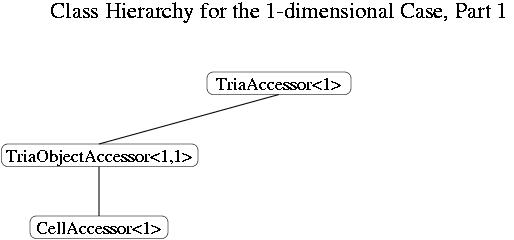
Wolfgang Bangerth, 1998, 1999, 2000
The class hierarchy of the accessor classes used to retrieve and store data in the triangulation and degree of freedom handler objects is one of the more complicated parts of the library. It makes heavy use of class templates with integers as template parameters as well as of explicit specialization of classes and member functions. Therefore, it is not so easy to see the connections and inheritance relations within this part of the class tree; this document tries to shed a bit of light onto this.
Furthermore, it lists the member functions that can be queried to obtain information from an iterator.
Table of contentsWhen using adative finite elements, the data structures often are extremely complex, requiring multiply indirected access and complex relationships between the different places where data is stored. The traditional way to handle this is to put all data which belongs together somehow into a structure or object; however, sometimes this can not be done efficiently, leading to either higher memory consumption (when you have to store many small data pieces and because you have to store a lot of pointers to other objects) or higher coding requirements (when you want to follow all those pointers to the object you desire).
Therefore, we took over a concept which was already used in the C++ standard template library, namely iterators and accessors. An accessor is an object that looks like if it had all the information stored but really only delegates the access to the right places; in fact, within this library, accessor store almost no information but know where to get everything from the complex and nested data structures the triangulation object offers. They have a simple interface which allows to extract any desired information from the triangulation and therefore makes access much easier and safer in three ways: first it performs range and parameter checking when in debugging mode; second, it encapsulates the access to the real data from the user, hiding the true data structures and thus allowing them without changing the user programs as well as those parts of the library which only act through accessors; and third by reducing the coding errors because of reduced complexity, since the chains of indirect access are replaces by simple commands.
Iterators are a related concept: while accessors act as if they were
structures with data contained in them, iterators act as if they were
pointers pointing to accessors. You can dereference them using the
-> and * operators as with any other pointer, but they have more
functionality. Essentially, they have overloaded ++ and -- operators,
which allow the next or previous object pointed to to be just about
anywhere in memory. A good introductory example are the iterators of
the STL list<T> class, which act on a linked list
as if it were a contiguous array. The iterators in this library go
even a step further: they do not point to different objects but rather
tell the associated accessor object which data to look at
next.
Additionally, there are different versions of the iterators which behave differently when being incremented or decremented: while raw iterators let the associated accessor point to any of the objects it is made for, normal iterators always point to objects which are in use. Usually, you will not want to see cells or lines which are there but are unused by the triangulation (these cells are somewhat like holes in the arrays of the triangulation; such things happen when unrefining a cell, the freed memory is then kept for a while because of better efficiency), so you will almost never want to use raw iterators; they are mostly there for internal use in the library. Normal iterators are almost like raw iterators, but whenever you call the ++ or -- operator, the look at what they are pointing at and skip all unused elements by increasing or decreasing the pointer as often as necessary to reach the next used object.
Finally, there are active iterators, which are the most important ones. They are like normal iterators but only point to active cells or lines. By active we mean that they have no children; in the context in which this library is used, this is equivalent to the fact that we do computations on these cells, lines or whatever. Active iterators are normal iterators which skip over all non-active cells, lines, etc when being incremented or decremented.
The triangulation accessors are used to retrieve and store data in the triangulation. There exist accessors for lines in one and higher dimensions, accessors for quads in two and higher dimensions, and so on. The general naming scheme is as follows:
TriaAccessor<dim> is a general base class
which is of not much interest.
TriaObjectAccessor<objectdim,spacedim> denotes
an accessor for an object with dimension
objectdim in a spacedim dimensional
space. It is derived from TriaAccessor<spacedim>.
CellAccessor<dim> presents the special
properties that a cell has. It is therefore derived from
TriaObjectAccessor<spacedimdim,spacedim>.
Their inheritance trees in the different space dimensions therefore look like this:

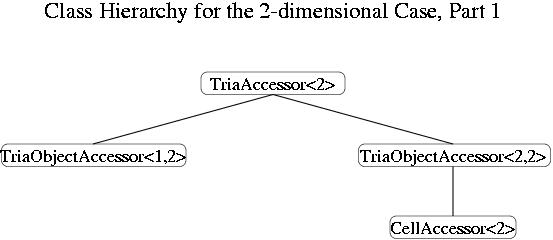

Some of the data is only useful if an object is a cell. For example, neighborship is only accessible for cells, while faces (e.g. lines in 2D) can't access their neighbors (neither the adjacent cells, nor the other faces it touches). Therefore, the CellAccessor classes are derived from whatever object a cell is in the respective dimension, i.e. from lines in 1D, from quads in 2D, and so on.
The Triangulation<1> class declares the following data
types which involve accessors:
typedef TriaRawIterator <1,CellAccessor<1> > raw_line_iterator;
typedef TriaIterator <1,CellAccessor<1> > line_iterator;
typedef TriaActiveIterator<1,CellAccessor<1> > active_line_iterator;
typedef raw_line_iterator raw_cell_iterator;
typedef line_iterator cell_iterator;
typedef active_line_iterator active_cell_iterator;
Since lines are cells in one space dimension, all line iterators are
cell iterators as well.
In two space dimensions, the following types are declared by the
Triangulation<2> class:
typedef TriaRawIterator <2,TriaObjectAccessor<1, 2> > raw_line_iterator;
typedef TriaIterator <2,TriaObjectAccessor<1, 2> > line_iterator;
typedef TriaActiveIterator<2,TriaObjectAccessor<1, 2> > active_line_iterator;
typedef TriaRawIterator <2,CellAccessor<2> > raw_quad_iterator;
typedef TriaIterator <2,CellAccessor<2> > quad_iterator;
typedef TriaActiveIterator<2,CellAccessor<2> > active_quad_iterator;
typedef raw_quad_iterator raw_cell_iterator;
typedef quad_iterator cell_iterator;
typedef active_quad_iterator active_cell_iterator;
typedef raw_line_iterator raw_face_iterator;
typedef line_iterator face_iterator;
typedef active_line_iterator active_face_iterator;
Since in this space dimension, quads are cells and lines are the faces
of cells, the appropriate face and cell iterators are declared in
terms of the underlying accessor types.
In three space dimensions, the following types are declared by the
Triangulation<3> class:
typedef TriaRawIterator <3,TriaObjectAccessor<1, 3> > raw_line_iterator;
typedef TriaIterator <3,TriaObjectAccessor<1, 3> > line_iterator;
typedef TriaActiveIterator<3,TriaObjectAccessor<1, 3> > active_line_iterator;
typedef TriaRawIterator <3,TriaObjectAccessor<2, 3> > raw_quad_iterator;
typedef TriaIterator <3,TriaObjectAccessor<2, 3> > quad_iterator;
typedef TriaActiveIterator<3,TriaObjectAccessor<2, 3> > active_quad_iterator;
typedef TriaRawIterator <3,CellAccessor<3> > raw_hex_iterator;
typedef TriaIterator <3,CellAccessor<3> > hex_iterator;
typedef TriaActiveIterator<3,CellAccessor<3> > active_hex_iterator;
typedef raw_hex_iterator raw_cell_iterator;
typedef hex_iterator cell_iterator;
typedef active_hex_iterator active_cell_iterator;
typedef raw_quad_iterator raw_face_iterator;
typedef quad_iterator face_iterator;
typedef active_quad_iterator active_face_iterator;
Since in this space dimension, hexes are cells and quads are the faces
of cells, the appropriate face and cell iterators are declared in
terms of the underlying accessor types.
We briefly state a short list of the functions offered by the
triangulation accessors. For a more complete discussion of these
functions, please refer to the online
API
documentation of the `grid' classes. These functions can be
accessed by iterator->function() if iterator
is a cell-, face-, hex-, quad-, or line-iterator. Some functions are
not available for all iterator types, which is noted for the
individual entries.
true for all iterators that are either normal iterators
or active iterators, only raw iterators can return
false. Since raw iterators are only used in the
interiors of the library, you will not usually need this function.
The DoFAccessor classes provide access to the degree of freedom information associated with cells, lines, etc. The inheritance relationship is much the same as for the triangulation accessor classes, as can be seen from the following pictures.
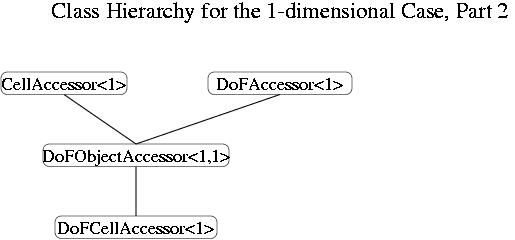
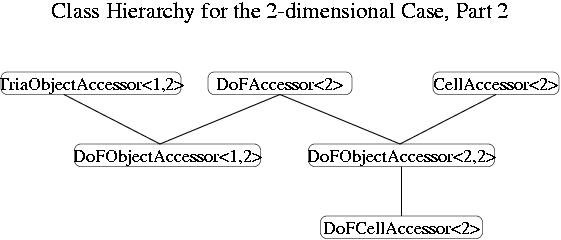
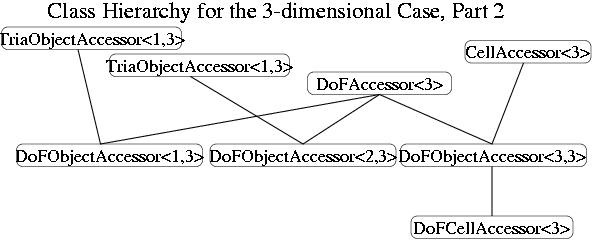
The main difference to the triangulation accessor hierarchy is that we want the DoF accessors to provide the information about the degrees of freedom, but for convenience also that of the triangulation. This way, we can get all the information from one object rather than needing two which work in parallel, and the class hierarchy shown above does exactly this.
For the named reason, it is necessary to derive the
DoFObjectAccessor<1,dim> from the
TriaObjectAccessor<1,dim> class of the
triangulation accessor hierarchy, as well as the
DoFObjectAccessor<2,dim> from the
TriaObjectAccessor<2,dim>. However, we would also
like to include the functionality added by the CellAccessor class;
this is done through some template magic: when in one space dimension,
the DoFObjectAccessor<1,1> is derived from
CellAccessor<1>, while when in higher dimensions, it is derived
from DoFObjectAccessor<1,dim>; the same applies for
the DoFObjectAccessor<2,dim> class. Note that this
way, CellAccessor is always a base class to DoFCellAccessor and the
inheritance lattice is dimension dependant; the exact way of achieving
this is complicated but not of interest here.
The typedefs done by the DoFHandler class are much alike those done by the Triangulation class. They could be summarized as follows:
For one space dimension:
typedef TriaRawIterator <1,DoFCellAccessor<1> > raw_line_iterator;
typedef TriaIterator <1,DoFCellAccessor<1> > line_iterator;
typedef TriaActiveIterator<1,DoFCellAccessor<1> > active_line_iterator;
typedef raw_line_iterator raw_cell_iterator;
typedef line_iterator cell_iterator;
typedef active_line_iterator active_cell_iterator;
Since lines are cells in one space dimension, all line iterators are
cell iterators as well.
For two space dimensions:
typedef TriaRawIterator <2,DoFObjectAccessor<1, 2> > raw_line_iterator;
typedef TriaIterator <2,DoFObjectAccessor<1, 2> > line_iterator;
typedef TriaActiveIterator<2,DoFObjectAccessor<1, 2> > active_line_iterator;
typedef TriaRawIterator <2,DoFCellAccessor<2> > raw_quad_iterator;
typedef TriaIterator <2,DoFCellAccessor<2> > quad_iterator;
typedef TriaActiveIterator<2,DoFCellAccessor<2> > active_quad_iterator;
typedef raw_quad_iterator raw_cell_iterator;
typedef quad_iterator cell_iterator;
typedef active_quad_iterator active_cell_iterator;
typedef raw_line_iterator raw_face_iterator;
typedef line_iterator face_iterator;
typedef active_line_iterator active_face_iterator;
For three space dimensions:
typedef TriaRawIterator <3,DoFObjectAccessor<1, 3> > raw_line_iterator;
typedef TriaIterator <3,DoFObjectAccessor<1, 3> > line_iterator;
typedef TriaActiveIterator<3,DoFObjectAccessor<1, 3> > active_line_iterator;
typedef TriaRawIterator <3,DoFObjectAccessor<2, 3> > raw_quad_iterator;
typedef TriaIterator <3,DoFObjectAccessor<2, 3> > quad_iterator;
typedef TriaActiveIterator<3,DoFObjectAccessor<2, 3> > active_quad_iterator;
typedef TriaRawIterator <3,DoFCellAccessor<3> > raw_hex_iterator;
typedef TriaIterator <3,DoFCellAccessor<3> > hex_iterator;
typedef TriaActiveIterator<3,DoFCellAccessor<3> > active_hex_iterator;
typedef raw_hex_iterator raw_cell_iterator;
typedef hex_iterator cell_iterator;
typedef active_hex_iterator active_cell_iterator;
typedef raw_quad_iterator raw_face_iterator;
typedef quad_iterator face_iterator;
typedef active_quad_iterator active_face_iterator;
Since degree of freedom accessors are derived from triangulation accessors, they inherit the functionality of these accessors, but add some of their own. We only list the additional functionality below. For a full reference, including data types of parameters and return values, please refer to the general API documentation of the `DoF' classes.